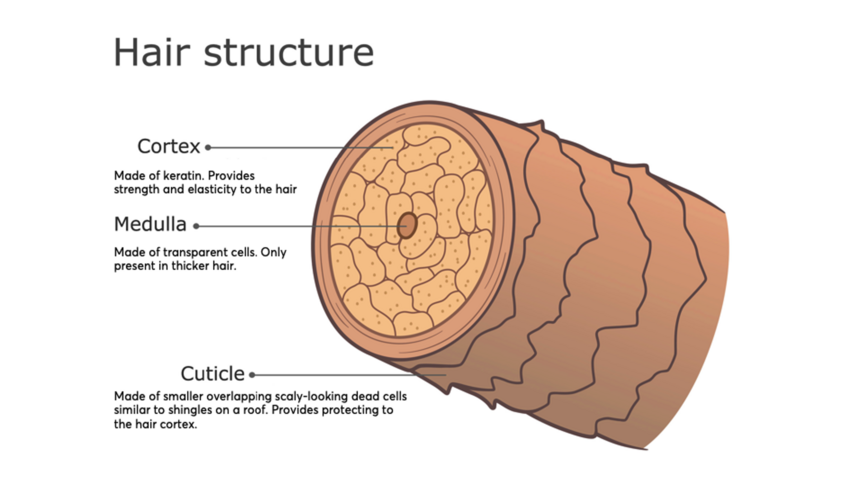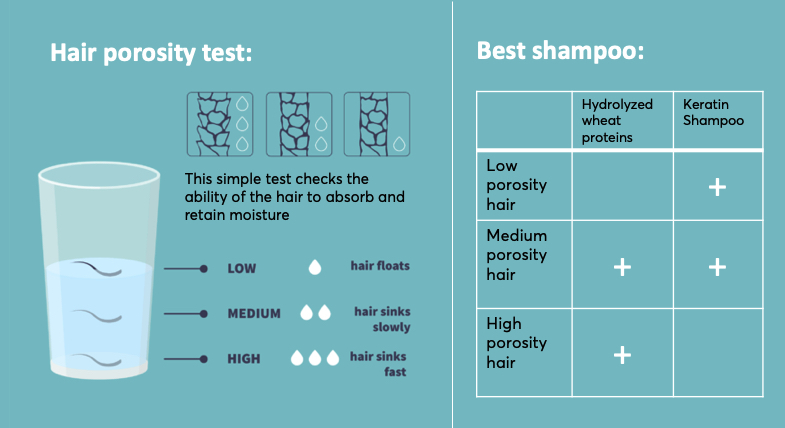Hair porosity - best treatments according to dermatologists

Hair porosity determines the ability of the hair shaft to absorb and retain moisture. Without proper care, low-porosity hair can be heavy and oily, and high-porosity hair can be dry and frizzy.
What are the three layers of the hair shaft?
Hair can be divided into two main parts. First, there are the hair follicles that are rooted into the scalp and responsible for growing new hair. Second, there are the hair shafts that grow out of the hair follicles.
The hair shaft consists of 3 main layers:
- Cuticle: The protective outer layer of the hair shaft is made of smaller overlapping scaly dead cells that resemble shingles on a roof.
- Cortex: The core layer of the hair shaft that provides strength and relativity of the hair. It is made of long keratin rope-like fibers held together by disulfide and hydrogen bonds.
- Medulla: The innermost layer of the hair shaft is only present in thicker hair. It is made of soft, thin, transparent cells and air spaces.

What determines hair porosity?
Hair porosity depends on the cuticle – the upper protective layer of the hair shaft. The outer layer of the hair shaft has two functions. One is to protect the hair cortex from harsh chemicals and toxins, and the other is to allow water and moisturizing compounds to reach the hair cortex. When the "shingles" of the cuticle are tight, the hair is considered to be low porosity. When the "shingles" of the cuticle are wider, the hair has high porosity.
What are the levels of hair porosity?
Low porosity: Cuticles are close together, and the hair is usually heavy or oily and susceptible to product buildup. If the cuticles are too tight, water and oils to the core of the hair shaft will accumulate on the hair's surface.
Medium (optimal) porosity: Cuticles that are less tightly bound allow water and hair products to be easily absorbed and retained. Hair with medium porosity is usually easier to style and will hold styles and colors for longer. It dries quickly and looks healthy, shiny, and glossy.
High porosity: Cuticles that are more widely spaced quickly absorb water and hair moisturizers but do not easily retain them. As water is not retained by high porosity hair, it will appear frizzy, dry, and break easily. This means that while moisture can enter the cuticle easily, it can exit just as quickly. This type of hair gets wet fast and can get tangled, dry, and dull if not maintained correctly.
What is your hair porosity?
To test your hair's porosity, take a strand and place it in a glass of water.
- If your hair remains floating at the top of the glass, you have low-porosity hair.
- You have medium-porosity hair if your hair floats down to somewhere in the middle.
- If your hair sinks to the bottom of the glass, you have high-porosity hair.
The effects of pH on hair porosity?
pH is a measure of the acidity or basicity of a solution. A solution with a pH lower than 7 is considered acidic, and a solution with a pH greater than 7 is considered basic or alkaline. As your hair has an acidic PH, usually 5.5, it will react much better to slightly acidic products. Alkaline or basic pH shampoos and conditioners cause the hair to swell and the cuticles to open - increasing the hair porosity. Alkaline shampoos will also increase the negative electrical charge of the hair fiber surface, increasing the friction between the fibers. This may lead to cuticle damage and fiber breakage. Shampoos with an acidic, lower pH will close the cuticle, reduce hair porosity, and generate less negative static electricity on the fiber surface, which will reduce hair dryness and frizz.
Interestingly, only 38% of the popular drugstore brand shampoos, against 75% of the salons' shampoos, presented a pH ≤ 5.0. Baby shampoos will usually have a pH of 7.0 to prevent eye irritation and tears and are not optimal for adult haircare.
What causes low porosity hair?
Any hair type can have low porosity. Low-porosity hair generally looks shiny because the cuticles lay flat. It can take a very long time to dry and can look dry even after products are applied. This type of hair is stronger and "healthier" than high-porosity hair and is less prone to split ends.
How to take care of low-porosity hair?
- Use keratin-free shampoos. Keratin is a large molecule that will not be absorbed in low-porosity hair.
- Look for shampoos and conditioners that contain hydrolyzed plant proteins. The short chains of hydrolyzed plant proteins can be absorbed into your hair without causing product buildup.
- To maintain shiny hair, look for a pH-balanced, slightly acidic shampoo with a pH that is lower than 5.5.
- If you want to use a conditioner, look for one that is silicone-free and dilute it with water before applying it to your hair.
- Do not use oils on your hair. These will make your hair heavier and oilier.
- If you would still like to use an oil on your hair, look for products with argan oil which is lighter and absorbs better than other oils.
- Heat will help open your cuticles. After you condition your hair, you can use a hooded dryer or cover your hair with a sealed cap.
What causes high porosity hair?
The porosity level of hair is mainly determined by genetics, heat usage, the pH of shampoo and conditioner, the water you use to wash it, and other environmental factors. Blow drying, bleaching, straightening, overwashing, and UV exposure are other common causes of high porosity hair. Damage to hair cuticles may make it harder for hair to retain moisture.
How to take care of high-porosity hair?
- Look for a pH-balanced, slightly acidic shampoo with a lower than 5.5. This type of shampoo will help tighten your hair cuticles and reduce hair porosity.
- Use a conditioner with added keratin or plant proteins.
- Look for ingredients like argan and avocado oil in shampoos and conditioners. These oils help moisturize hair.
- Help your hair retain moisture with leave-in conditioners and sealers.
- Use a heat protectant before you blow-dry, or use other heat styling treatments.
- Avoid hot water when shampooing and conditioning. Use lukewarm water instead.
What are the best products to balance hair porosity?
The MDhair Restore Shampoo:
The Restore Shampoo is a new type of keratin volumizing shampoo utilizing DHT blockers to help stimulate the hair follicles for stronger, thicker hair. It contains a highly effective blend of over 20 powerful ingredients, including berry extracts, ginseng root, rosemary leaf oil, pumpkin seed oil, tea tree oil, argan oil, and more. Probiotic lactobacillus ferment facilitates the production of antioxidants while strengthening the scalp's immunity and bacterial (biome) balance. Keratin and plant proteins reduce hair porosity, minimize breakage, and eliminate frizzing and tangling. It includes Fo-Ti root extract to improve scalp health and help reduce premature graying. It is pH-balanced, sulfate-free, paraben-free, fragrance-free, and color-safe.
The MDhair Restore Conditioner:
The Restore Conditioner, specially formulated for thin and damaged hair, is made with keratin and silk peptides and argan oil to help protect and strengthen your hair. It is formulated with 16 active botanical complexes to stimulate the roots and provide thicker-looking, healthier, shinier hair. It includes Fo-Ti root extract to improve scalp health and help reduce premature graying. It is pH-balanced, silicone-free, sulfate-free, paraben-free, fragrance-free, and color-safe.
Find the most effective hair growth products for you by taking the free hair assessment.




